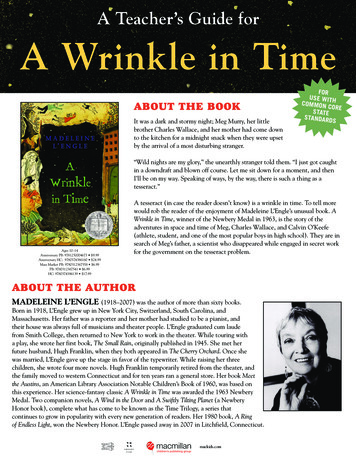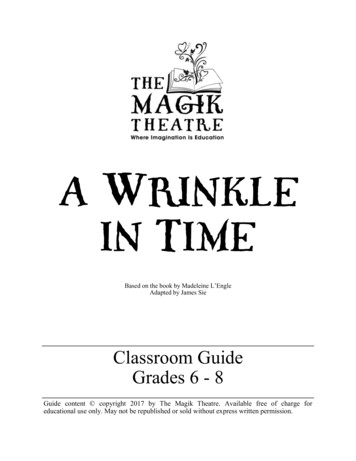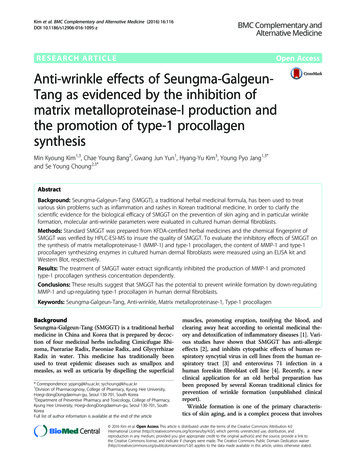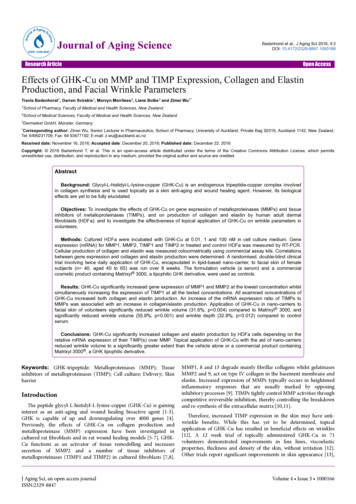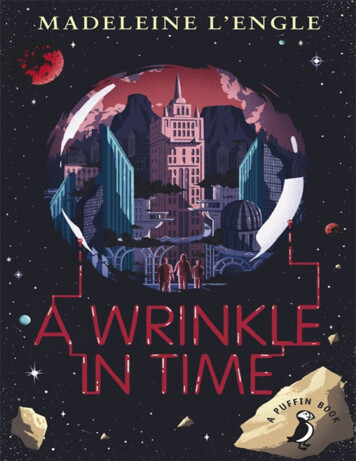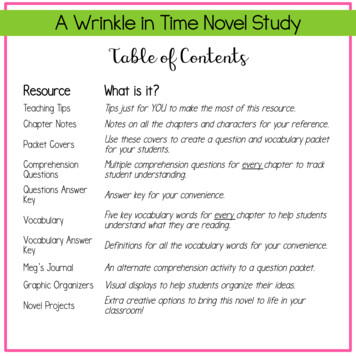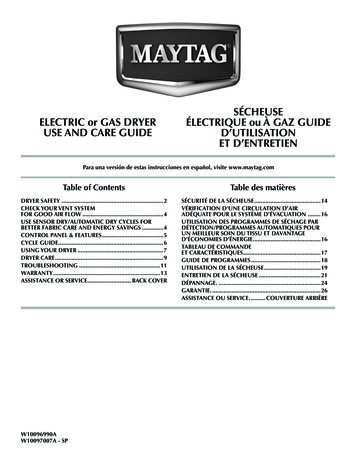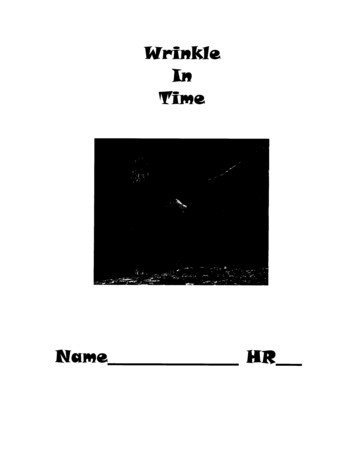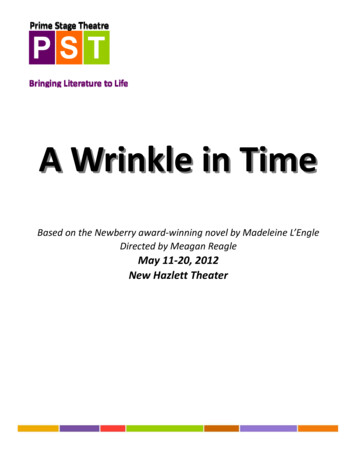
Transcription
A Wrinkle in TimeBased on the Newberry award‐winning novel by Madeleine L’EngleDirected by Meagan ReagleMay 11‐20, 2012New Hazlett Theater
These organizations support Prime Stage Theatre.Support them when you can!
FOR TEACHERS & STUDENTSPOST‐SHOW CHAT SESSIONSStay after the school matinees to ask questions of both the actors and the characters! During the 20‐minutepost‐show chat sessions, delve into the minds and reasoning of the characters and then ask questions of theactors about the rehearsal process, theatre performance, and their experiences working on that particularproduction. No registration required.ADOPT‐A‐SCHOOL PROGRAMPrime Stage Theatre’s flagship education program strives to increase adolescent literacy through theatre inunderserved and underperforming school districts in the Western Pennsylvania area. In this FREE program,schools receive tickets and books for each Prime Stage production, 10 in‐school workshops, and professionaldevelopment opportunities for teachers. If you would like your school to become involved, pleasedownload an application at our website, http://primestage.com/files/pdf/application aas.pdf.2011‐12 PROFESSIONAL DEVELOPMENT WORKSHOPS — “CREATIVE INQUIRY FOR LITERACY LEARNING”Bring WONDER into your classroom by introducing creative inquiry into your lessons. Learn how theatre art‐ists use questions and critical thinking in their work, and discover how to use these techniques to inspireyour students’ love of learning. This season there are three opportunities to expand your creative teachingskills and invigorate your practice: “Introduction to Creative Inquiry,” September 10, 2011 at the AlleghenyIntermediate Unit #3. “Engaging Disengaged Adolescents,” November 7, 2011 at the New Hazlett Theater.“Scientific Inquiry Is Not Just For Science,” April 23, 2012 at the Carnegie Science Center. For more informa‐tion and registration form, visit http://primestage.com/educators students/workshops.html or contactChristina Farrell, Education Director at cfarrell@primestage.com.OPPORTUNITIES FOR TEENS, FAMILIES AND ADULTSPrime Stage Theatre offers opportunities for people of all ages to get involved with the theater. Check outour website to learn about mentorships, volunteering, book readings and many other exciting events. Thereis something for everyone at Prime Stage! http://primestage.com/
A Wrinkle in TimeWelcome to Prime Stage Theatre:Bringing Literature to Life!03.05.2012Dear Educator,Antigone, PST 2011The Glass Menagerie, PST 2011Welcome to the 2011‐12 season at PrimeStage Theatre! We had a very successful sea‐son last year with acclaimed productions ofThe Legend of Sleepy Hollow, The Glass Me‐nagerie and Antigone. We are thrilled to wel‐come you this year to three productions thatwill inspire you to imagine and discover: TheScarlet Letter, The Elephant Man and A Wrin‐kle in Time.This Resource Guide is designed to providehistorical background and context, class‐room activities, and other curricular contentto help you enliven your students’ experi‐ence with the literature. We hope it will in‐spire you to use theatrical skills and creativethinking in your classroom in order to sparkpersonal connections with the themes andcharacters in the stories.If you have any questions about the information or activities in this guide, pleasedon’t hesitate to contact me. I’m happy to help and welcome your suggestions! Christina FarrellEducation Directorcfarrell@primestage.comResource Guide created byChristina Farrell for Prime StageTheatre. Please do not reproduceany part of the study guide forpublication without permission.Did you know Prime Stage Theatrehas been in existence forover 13 years. Prime Stage Theatre’svery first production wasA Woman Called Truthabout Sojourner Truth. Prime Stage Theatrefirst performed at theStation Square Playhouse(now Hard Rock Café).Check out what’s inside!A Wrinkle in Time in 30seconds or Less!5Madeleine L’Engle5Meagan Reagle, Adapt‐ 6ing a Novel for the StageThe World in g and Pre‐Show Activities11‐12Reading, Writing, Speak‐ing, & Listening: 1.1‐1.8Reading Activities13‐15Post‐Reading and Post‐Show Activities16Science and Technology:3.2, 3.4, 3.6, 3.8Attending thePerformance17Discussion Questions,Classroom Resources18Curriculum Connections CornerPrime Stage Theatre iscommitted to directlycorrelating our programsto the PDE AcademicStandards. A Wrinkle inTime and this resourceguide may be used toaddress the followingcurriculum content stan‐dards:Volume 3, Issue 3Arts and Humanities:9.1‐9.4
A Wrinkle in TimePage 5Summary—A Wrinkle in TimeA Wrinkle in Time in 30 seconds It was a dark and stormy night. MegMurry, an awkward teenager, lay awakeworrying about her father who has beenmissing for over two years. She joins heroddly gifted younger brother, CharlesWallace, and beautiful scientist mother inthe kitchen for a midnight snack. They aresoon surprised by a visit from an eccentricwoman named Mrs. Whatsit, who seemsto be able to read minds. She startlesMeg’s mother by confirming the existenceof a tesseract— a wrinkle in the fabric ofspace and time.The next afternoon, Meg and Charles Wal‐lace visit Mrs. Whatsit and find CalvinO’Keefe, a popular and intuitive boy fromMeg’s school waiting for them. They meetMrs. Whatsit and her two friends, Mrs.Which and Mrs. Who, who explain thatthe children must travel through spaceand time to rescue Mr. Murry who hasbeen captured by an evil force.They travel to the planet Uriel, whereMrs. Whasit transforms into a beautifulcreature something like a centaur and anangel. This creature shows them the evilforce, a dark shadow, which is overcomeby a star’s light. With the help of theHappy Medium, Meg is able to see hermother back home.Now knowing what they are up against,they travel to the planet Camazotz whereMr. Murry is imprisoned. This planet looksvery similar to Earth, except everything isin perfect order. The people all move inperfect rhythm to the pulse of IT, a giantdisembodied brain that rules all the be‐havior on the planet. The kids soon arriveat the Central Intelligence building wherethey are questioned by the Man with RedEyes. He tries to overtake Charles Wal‐lace’s mind, and despite his exceptionalintelligence, Charles Wallace is overpow‐ered. He begins to robotically voice themessage of IT, then leads Meg and Calvinto Mr. Murry. Meg and Calvin manage topull Mr. Murry from his holding cell, butare unable to defend themselves from IT’spower. They tesser to a gray planet calledIxchel, leaving Charles Wallace behind.On Ixchel, Meg is cared for by a blind,furry creature whom she names AuntBeast. The three Mrs. W’s reappear andtell Meg that she has one thing that ITdoes not have, but she must discover thisweapon herself. Meg realizes that shemust return to Camazotz alone to saveCharles Wallace.Back on Camazotz, Meg confronts IT andrealizes that her power to love will defeatthe evil darkness. Her love restoresCharles Wallace to his true identity andtogether they tesser back to Earth. Thefamily joyously reunites, and the Mrs. W'svisit the happy scene en route to furthertravels.or less.Meg Murry, an awkward teenager, is sentby on an adventure through time andspace with her gifted little brother andpopular friend to rescue her father fromthe evil forces that hold him prisoner onanother planet.Madeleine L’EngleMadeleine was born on November 29th,1918, and spent her formative years inNew York City. Instead of her school work,she found that she would much rather bewriting stories, poems and journals forherself, which was reflected in her grades(not the best). She was, in fact, branded asstupid by some of her teachers. However,she was not discouraged.At age 12, she moved to the French Alpswith her parents and went to an Englishboarding school where her passion forwriting continued to grow. She flourishedduring her high school years back in theUnited States at Ashley Hall in Charleston,South Carolina. She went to Smith Collegeand studied English with some wonderfulteachers as she read the classics and con‐tinued her own creative writing. Shegraduated with honors and moved into aGreenwich Village apartment in New York.She worked in the theater, where Equityunion pay and a flexible schedule affordedher the time to write! She published herfirst two novels during these years—ASmall Rain and Ilsa—before meeting HughFranklin, her future husband. They eventu‐ally moved to Connecticut to raise theirdaughter, son and an adopted daughteraway from the city in a small dairy farmvillage with more cows than people. Theybought a dead general store, and broughtit to life for 9 years before returning to thecity in 1959.After Hugh’s death in 1986, it was herwriting and lecturing that kept her going.She wrote over 60 books, before passingaway on September 6, 2007.She won many awards for writing, includ‐ing several Newbury honors, the SmithCollege Award "for service to communityor college which exemplifies the purposesof liberal arts education", the SophiaAward for distinction in her field, the ALANAward for outstanding contribution toadolescent literature and the NationalHumanities Medal. In 1985 she was aguest speaker at the Library of Congress,giving a speech entitled "Dare to be Crea‐tive!" In 1997 she was recognized for Life‐time Achievement from the World FantasyAwards.From: http://en.wikipedia.org/wiki/Madeleine L'Engle
Volume 3, Issue 3Page 6Meagan Reagle, DirectorPrime Stage’s production of A Wrinkle inTime is directed by Meagan Reagle. Thismakes Meagan’s 5th season with PrimeStage Theatre. She has served as assis‐tant and movement director for Antigone,movement director for The Legend ofSleepy Hollow, assistant director for ToKill a Mockingbird, Of Mice and Men, 12Angry Men, & Tuesday’s with Morrie,dramaturg for The Outsiders and Romeo& Juliet, and stage manager for OurTown and Tuesday’s with Morrie. Othercompanies include Ghostlight TheatreTroupe, Point Park Conservatory, Pitts‐burgh Playwrights, City Theatre, Pitts‐burgh REP Company, South Park Thea‐tre, Pittsburgh New Works, PittsburghCLO, barebones productions, TuesdayMusical Club, & currently Dancer/ResidentArtist with kNOTDance. She is a graduateof Point Park University with a BA in Thea‐tre Arts and also studied physical theatreunder the direction of Mark C. Thompson.She is also the director of the Prime StageTeen Advisory Board’s production Every‐thing Is Fine, raising awareness about TeenDating Violence.Adapting a Novel for the StageDirectors, playwrights and productionteams have to make many decisions whenthey adapt a novel for the stage. It is notsimply reading a book out loud. All thoseworking behind the scenes must considerwhat emotions, images, sounds or move‐ments to highlight from the book—andhow to do it. Director Meagan Reaglegives some insight into her process:Why do you think A Wrinkle in Time isstill relevant fifty years after its publica‐tion?MR: It really provokes the imagination. Itmoves you. Unlike other children’s booksit makes you look and do things. It inspiresthought, active doing, wonder and amaze‐ment.What message stands out to you?MR: I came across the section where Meghas an epiphany and looks at her fatherand has a little dialog with herself. “Nowthat my father is here, things are not fixed.I have to do it. I have to be the one tomake things happen or nothing is going tohappen.” That is a huge lesson for adoles‐cent life into adulthood. You’ve got be theone who creates the action.Why do you think this story will workwell on the stage?MR: Madeleine L’Engle’s story is aboutbeing productive, proactive, and accom‐plishing the tasks of hand. That is theatre!A lot of stories are more thought‐based,but L’Engle always kept in mind that thereis something to be done!There are so many magical moments inthis story. How will you handle the spe‐cial effects?MR: In order bring those effects to life, Iwill create a unique feel and sound forlooked directly at the images described ineach place in the story. I talked with Noahthe book and letting my imagination doabout how I want each place to feel. Forthe rest of the work. For instance, L’Engleinstance, Camazotz will have a militantwrote about a character having a creakymodern feel. The choreography will bevoice, the imageruled by time, veryinstantly brought to A voice emerged from among turned-up progressive.my mind were origi‐coat collar, stole, scarves, and hat, anal Monty PythonHow do you workvoicelike an unoiled gate, but some- with the productionskits. Another, veryinfluential, is Mrs.how not unpleasant. (Chapter One) team?Whatsit’s sheets areMR: First we decidedescribed as paisley print and colorful. Iwhat scenes to look at, then think about itrecognized a correlation between thatfor a week or two. We get back togethercostume and the wings she’s supposed toand compare ideas – no matter how largehave on Uriel. I am always looking in depthor impractical – then discuss and decideat the language she wrote and how thingswhich ones to go with. I think about theconnect.process like a triangle – my ideas and theirideas come to point.How are you collaborating with otherorganizations on this production?What is your guiding vision for this pro‐MR: Mike Hennessy from the Carnegieduction of A Wrinkle in Time?Science Center will be our Projection De‐MR: BIG, Fun and Fabulous! Being certainsigner for this show. Projections will bein the most uncertain of moments!the set, adding color to all the worlds theDiscuss: If YOU were the director children travel to. The Science Center isproviding a special projection ball that weWhat is the main theme from the novelwill use for the Happy Medium’s world.that you’d want your audience to thinkThe ball uses projections that circleabout when they leave the theater?around—it will be cool.We are also working with the PittsburghYouth Symphony Orchestra who will beplaying the music. Craig Johnson (PYSOManaging Director) gave us a piece writ‐ten by Noah Kahrs, a percussion and com‐position student from CAPA (Creative andPerforming Arts High School) that wereally impressed us. We asked Noah is towrite music for the production, which berecorded by members of PYSO and playedduring the performance. I want music thatHow might you portray time travel andphysical transformation in the theater?What parts of the book might you leaveout of the play? What do you think ismost essential?Which characters do you most relate to,and how do you think your feelings mightaffect the way you portray the characteron stage?
A Wrinkle in TimePage 7Putting it in ContextThe World in 1962:When A Wrinkle in Time was published in 1962, America was in the midst of the Cold War. Readers quickly associated the uniform society ofCamazotz with the dangers of Communism. The hot‐button topic caused some to become passionately interested in the book, while othersscorned it for being too overtly anti‐Communist. America was also coming out of the economic boom of the 1950’s and moving into a newdecade of social unrest and moral reevaluation. People around the world were beginning to think differently about civil rights, religion, therole of government and popular culture.Events of the Early 1960’sMay 6, 1960‐ President Eisenhower signs the Civil Rights Act of 1960.March 1, 1961‐ President Kennedy initiates 17 billion dollar nuclearmissile program, and creates the Peace Corps.April 25, 1961‐ The US invades Cuba at the Bay of Pigs. It is a failure.April 12, 1961‐Yuri Gagarin of the USSR becomes the first man inspace.February 1 ‐ 4, 1960— Black college students from North CarolinaAgricultural and Technical College sat down at a segregatedWoolworth's lunch counter in Greensboro, North Carolina andrefused to leave. They are then allowed to stay at the counter,but are refused service. The sit‐in captured the media attentionand soon spread all over the south.August 13, 1961 ‐ EastGerman border guardsbegin construction ofBerlin Wall, separatingCommunist East Ger‐many and DemocraticWest Germany.August 28, 1963 ‐ The Marchon Washington attracts over200,000 people to Washing‐ton, D.C. With the peopleconcentrated around theLincoln Memorial, MartinLuther King Jr. gives his “IHave a Dream” speech.November, 1960 ‐ John F. Kennedy nar‐rowly wins the Presidency over Vice‐President Richard Nixon, Kennedy is thefirst Catholic to ascend to the Presidency.November 22, 1963 ‐ President Kennedy isassassinated in Dallas, Texas by Lee Har‐vey Oswald.May 4, 1961‐ The Congress of Racial Equality sends “Freedom Riders”on bus trips to test the implementation of new laws prohibiting segre‐gation in interstate travel facilities. A mob in Alabama sets the riders'bus on fire, but the program ultimately succeeds.September 15, 1961‐ The US starts underground nuclear testing.1961‐ President Kennedy advises Americans to build fallout shelters.1962‐ The Supreme Court, rules against prayer in public schools.1962‐ John Glenn becomes the first American to orbit the earth.October 22, 1962‐ Cuban Missile Crisis: Soviets establish missile basesin Cuba, Kennedy orders a naval blockade to divert any missiles fromarriving in Cuba.1962– The Beatles’ first No. 1 on the British charts: “Love Me Do.”January 1963 ‐ Alabama Governor Wallace's "Segregation Forever"speech is given at his inauguration.June 11, 1963 ‐ President Kennedy proposes the Civil Rights Bill.September 15, 1963 ‐ Four Black girls are murdered attending Sundayschool in the bombing of the Sixteenth Street Baptist Church in Bir‐mingham, Alabama. As a result Riots erupt in Birmingham, and twomore black youths are killed in the violence.September 24 , 1963‐ Nuclear Test Ban Treaty is ratified by Senate.November 24, 1963 ‐ President Johnson escalates American's militaryinvolvement in the Vietnam War.
Volume 3, Issue 3Page 8CharactersCast:The cast of the theatre adaptation onlyincludes seven actors. Therefore, someactors are required to play several roles.It also means that not all the charactersin the book will appear in the stage pro‐duction.Look at the descriptions on this pageand think about how you might choosea cast to portray these characters.What physical characteristicswould you look for in the actorplaying each character? Why?What vocal quality would youexpect each character to have?Would they speak slowly,quickly, gravelly, squeaky?Which roles might be shared byone actor? How would makeeach character unique?Meg Murry:Meg feels out‐of‐place in her town, her school and even in her own family. In her own eyesshe is ugly, stupid and overly‐emotional. But her bad feelings cause her to act out aroundothers , only making things worse. She wishes that her father would return so that every‐thing will return to normal and all her problems will be solved. But in the end, she learnsthat she will have to solve her problems on her own and must find the self‐assurance tosave her family.Charles Wallace:A genius with a keen sense of intuition about others, Charles Wallace is a remarkable littleboy in every sense. Although he possesses an astounding intellect, he realizes that playingdumb is sometimes safer, so he doesn’t speak and endures the taunts of the townspeople.Charles Wallace’s ability to tap into others’ minds combined with his need to know every‐thing causes him to fall into the mesmerizing trap of IT.Calvin O’Keefe:Although Calvin appears to have it all—good looks, athletic ability, popularity—he feels outof place among his own family members. It is with the Murry family that Calvin first feels asense of belonging, making Meg consider that perhaps she’s not so bad off after all. Cal‐vin’s gift of communication tells us that words can be a powerful weapon.Mrs. Whatsit:The mystery contained within Mrs. Whatsit’s name is demonstrated in her many forms.During her first entrance, she is bundled in mismatched clothes so that “the age or sex wasimpossible to tell.” Later, Mrs. Whatsit transforms into an entirely different form alto‐gether—a majestic winged centaur‐like creature—and we learn that she was once a star.Yet, she seems to be the most human of the three Mrs. W’s and she demonstrates thatkeeping a sense of humor is an important part of fighting evil.Mrs. Which:Mrs. Which is the clear leader of the three Mrs. W’s, yet for all herpower, she struggles to materialize physically and express herselfthrough speech. She has a hard time remembering human needs,which is demonstrated when she accidentally places the kids on a2D planet. Yet, she shows her humor by appearing as a witch witha pointed hat and broomstick. Meg feels as though she can trustMrs. Which implicitly.Aunt Beast:The kids are initially shocked by the unfamiliar and grotesque bod‐ies of the creatures on the planet Ixchel. But Meg soon learns thatappearances can be deceiving and develops a close friendship withthe kind, telepathic creature she names Aunt Beast. Although bothAunt Beast and IT can read minds, Aunt Beast uses her power forcommunication and understanding.The Man with the Red Eyes:Although he first appears to be the bad guy in the story, The Manwith the Red Eyes is simply a mouthpiece through which IT com‐municates. He tries to win the kids over by explaining that he isonly there to save them from grief and pain, if only they’d just givein. But Meg comes to understand that suffering is part of freedom.Mrs. Who:Through her ongoing stream of quotes in many languages, Mrs. Whoreminds us that the battle of good vs. evil is an ongoing social en‐deavor which has stretched across all times and cultures. Mrs. Whogives Meg her glasses as a gift on Camazotz, which suggests Meg'sability to see what the others cannot and reinforces the idea thatMeg's faults are actually sources of power.IT:Embodied in a giant brain, IT strives to control all others and forcethem into a uniform existence. But this shape leaves him “heartless”and Meg defeats his power through her unwavering love. IT teachesus that reason without compassion leads to devastating results.Mr. Murry:Meg pictures her father as a superhero who will come to her rescue.But Mr. Murry is slow to understand what has happened to CharlesWallace and Meg realizes that he is simply a regular man with faults.Despite his sincere desire to help her, Meg realizes that she mustdepend on herself.Mrs. Murry:Mrs. Murry proves that smart girls can be pretty. Meg aspires tohave her mother’s strength of spirit in the face of adversity.
Page 9A Wrinkle in TimeThemesA Wrinkle in Time contains many rich themes for exploration and discussion. Below are listed someprominent themes from the novel with supporting statements. Use these statements to spark discus‐sion or debate with your class. You may identify contradictions within the novel itself or controversialissues that are personally meaningful to you.Good vs. Evil: Through the use of quotes and historical reference, the novel suggests a never‐ending battle between the forces of Light and Dark.In the novel, Good is associated with love, individual creativity, moral responsibility and free will. Evil is associated with conformity,hatred, submission to authority, and lack of personal responsibility and initiative.The novel suggests that good and evil can sometimes look a lot alike, but people must use individual judgment to distinguish them.Appearances: Many characters in this story have deceiving appearances. Charles Wallace looks the same when under IT’s control, but is not the sameinside. Aunt Beast appears frightening and strange at first, but proves to be loving and compassionate.Meg worries that her awkward appearance isolates her from the rest of her peers. But she learns that her differences are her strengths,and what lies within is beautiful and powerful.Wisdom and Knowledge: Meg is brilliant, yet is a failure as a student. This implies that true wisdom lies outside the confines of education.IT is portrayed as a disembodied brain—all reason with no heart. Meg’s wisdom lies in her ability to trust her emotions.The real danger may be in thinking you know more than you do. This novel shows that there is more to the universe than we may beable to comprehend, and our humanity lies in embracing the mysteries beyond our grasp.Language and Communication: This novel makes us reconsider the many ways that we are able to communicate. Although language is our primary choice, we learnthat it is limited compared to music, touch, intuition, sensory awareness and even mind‐reading.Mrs. Who’s use of quotes shows the enduring nature of words and how they can have power across all times and cultures.Fate and Free Will: The novel's portrayal of Camazotz suggests that happiness is meaningless in the absence of free will.The children are often thrust into situations by the Mrs. W’s without knowing where they are going. This leaves us to wonder if theyhave complete free will or not.Love: In the novel, Love conquers all. Yet, love blinds Meg to her father’s weak‐nesses at first and she must develop a more realistic love to achieve personalsuccess. Love isn’t blind, but allows us to see the truth of what lies beneaththe surface.Love is seen as both a universal, cosmic force for good, as well as a personal,human quality that binds family and friends.Fear: Through Meg’s example we learn even the bravest heroes have fear, but theyface their fears head on.The novel detaches fear from any specific threat (the kids are afraid of theBlack Thing without knowing what it does) in order to make its evil more ab‐stract and absolute.Women’s Roles: Choose Love over Fear at Occupy PhillyPhoto: Tony Heriza Copyright: AFSCA Wrinkle in Time’s success is due in part to the portrayal of a feisty, intelligent female heroine whose ultimate lesson is self‐reliance.Mrs. Murry breaks the stereotype that smart girls can’t be pretty. She is the model professional mother who manages to cook dinnerwhile conducting experiments in the lab.The strongest characters are all women, including the Mrs. W’s and Aunt Beast, whereas Charles Wallace succumbs to IT, Mr. Murryturns out not to be the superhero Meg had hoped and Calvin is ultimately unable to be Meg’s protector.
Volume 3, Issue 3Page 10Themes (Cont.)Shakespeare—The Tempest: L’engle includes many quotes and references to Shakespeare’s The Tempest through the novel. Just as in A Wrinkle in Time, The Tempesttakes place in a world of illusions. The Tempest features a sorcerer who strives to take away the free will of others and Ariel, like Meg’sfather, is locked away in a column (a cloven pine.)Religion: Religious imagery and allusion are woven throughout A Wrinkle in Time. But some people thinkit’s too Christian, while others think it’s not Christian enough. It ranks number 23 on the most‐banned book list, primarily because Christians objected to Jesus being included equally on thelist of other historical figures that have fought evil, as well as claims that the book indoctrinateschildren with Eastern religions and mystical practices through references and imagery of crystalballs, psychic healing and telepathy.Because the novel lacks a clear message about the role of religion, readers are left to decide forthemselves what to think. (Perhaps this reinforces the novel’s main theme of free will and indi‐viduality.)Art and Music: Artists, musicians and philosophers are listed as the key fighters against evil in the world—compared to the traditional warrior stereotype.The novel suggests that in order to fully understand the richness of the universe, one must con‐sider musical qualities, color, texture, smells, tastes and spatial qualities.Personal and Moral Responsibility: Rembrandt, Jakobs Kampf mit dem EngelMeg’s initial dependence on her father can be compared to those on Camazotz who relinquishpersonal control to an all‐knowing overseer. But when Meg finally takes responsibility herself, shebecomes truly free.The Evil in the book can only be defeated by those who love others. This suggests that world’scondition relies on each individual’s ability to give and receive love in return.GlossaryWhat is What?!?Madeleine L’Engle intentionally used chal‐lenging vocabulary in A Wrinkle in Timebecause she believed that people under‐estimated children’s ability to absorb diffi‐cult language. We have listed some of themost unfamiliar words here.Have students record unfamiliar words asthey encounter them while reading thebook. Students should then look up defini‐tions in a dictionary. Vocabulary activitiescould include a word wall, word ball ornew sentence generation.PDE Academic Standards 1.7‐1.8AMBROSIA—the food of the gods; an espe‐cially delicious treatBELLIGERENT—warlike or hostileBILIOUS— irritable, cranky; extremely un‐pleasant or distasteful (as in bile)CONNOTATIONS—implied meaningsCORPOREAL— of the nature of the bodyDAIS—raised platform at the front of a roomDECIPHER—to discover the meaning of; tointerpret through the use of a keyDELINQUENT—failing in or neglected dutiesor obligationsDICTION—the accent, inflection or enuncia‐tion of speechDISEMBODIED—removed from the body, asin a spirit or soulDISSOLUTION— dissolving into parts; break‐ing a tie or unionGAIT—the manner of one’s walkILLUMINATION—the act of shining lightupon;intellectual or spiritual enlightenmentINEXORABLE—unyielding, unalterableINTOLERABLE—insufferable, can’t be with‐stoodLINIMENT—a liquid preparation for rubbingon sprains or bruisesMORASS—marshy groundMYOPIC—near‐sighted (as in sight); narrow‐minded or short‐sightedOBLIQUELY—diverging from a straight line orcoursePEDANTIC—overly concerned with minutedetails, especially in teachingPINIONED—prevent a bird from flying byremoving its wing, or disabling a person inthat mannerPRODIGIOUS—extraordinary in size, amount,extent or degree; wonderful or marvelousREVERBERATED—echoed or resoundedSADIST—person who enjoys being cruelSONOROUS— rich and full in soundSPARSE—thinly scattered; not thick or denseSUPINE—lying on the back, face or front up‐
by on an adventure through time and space with her gifted little brother and popular friend to rescue her father from the evil forces that hold him prisoner on another planet. Summary—A Wrinkle in Time Madeleine L'Engle Page 5 A Wrinkle in Time giving a speech entitled "Dare to be Crea‐ tive!"

